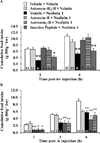Nesfatin-1: a novel inhibitory regulator of food intake and body weight
- PMID: 20546141
- PMCID: PMC4079085
- DOI: 10.1111/j.1467-789X.2010.00770.x
Nesfatin-1: a novel inhibitory regulator of food intake and body weight
Abstract
The protein nucleobindin 2 (NUCB2) or NEFA (DNA binding/EF-hand/acidic amino acid rich region) was identified over a decade ago and implicated in intracellular processes. New developments came with the report that post-translational processing of hypothalamic NUCB2 may result in nesfatin-1, nesfatin-2 and nesfatin-3 and convergent studies showing that nesfatin-1 and full length NUCB2 injected in the brain potently inhibit the dark phase food intake in rodents including leptin receptor deficient Zucker rats. Nesfatin-1 also reduces body weight gain, suggesting a role as a new anorexigenic factor and modulator of energy balance. In light of the obesity epidemic and its associated diseases, underlying new mechanisms regulating food intake may be promising targets in the drug treatment of obese patients particularly as the vast majority of them display reduced leptin sensitivity or leptin resistance while nesfatin-1's mechanism of action is leptin independent. Although much progress on the localization of NUCB2/nesfatin-1 in the brain and periphery as well as on the understanding of nesfatin-1's anorexic effect have been achieved during the past three years, several important mechanisms have yet to be unraveled such as the identification of the nesfatin-1 receptor and the regulation of NUCB2 processing and nesfatin-1 release.
© 2010 The Authors. obesity reviews © 2010 International Association for the Study of Obesity.
Conflict of interest statement
A.S., M.G and Y.T. have nothing to disclose.
Figures


Similar articles
-
Identification of nesfatin-1 as a satiety molecule in the hypothalamus.Nature. 2006 Oct 12;443(7112):709-12. doi: 10.1038/nature05162. Epub 2006 Oct 1. Nature. 2006. PMID: 17036007
-
The role of nesfatin-1 in the regulation of food intake and body weight: recent developments and future endeavors.Obes Rev. 2013 Nov;14(11):859-70. doi: 10.1111/obr.12063. Epub 2013 Aug 27. Obes Rev. 2013. PMID: 23980879 Free PMC article. Review.
-
Nesfatin-1 exerts long-term effect on food intake and body temperature.Int J Obes (Lond). 2012 Dec;36(12):1514-21. doi: 10.1038/ijo.2012.2. Epub 2012 Jan 31. Int J Obes (Lond). 2012. PMID: 22290539
-
Role of NUCB2/Nesfatin-1 in the hypothalamic control of energy homeostasis.Horm Metab Res. 2013 Dec;45(13):975-9. doi: 10.1055/s-0033-1351324. Epub 2013 Sep 18. Horm Metab Res. 2013. PMID: 24048879 Free PMC article.
-
NUCB2/nesfatin-1 - Inhibitory effects on food intake, body weight and metabolism.Peptides. 2020 Jun;128:170308. doi: 10.1016/j.peptides.2020.170308. Epub 2020 Mar 27. Peptides. 2020. PMID: 32229144 Review.
Cited by
-
Peripheral signals mediate the beneficial effects of gastric surgery in obesity.Gastroenterol Res Pract. 2015;2015:560938. doi: 10.1155/2015/560938. Epub 2015 Apr 15. Gastroenterol Res Pract. 2015. PMID: 25960740 Free PMC article. Review.
-
Nesfatin-1: A Novel Diagnostic and Prognostic Biomarker in Digestive Diseases.Biomedicines. 2024 Aug 20;12(8):1913. doi: 10.3390/biomedicines12081913. Biomedicines. 2024. PMID: 39200377 Free PMC article. Review.
-
Fibroblast growth factor 21, assisted by elevated glucose, activates paraventricular nucleus NUCB2/Nesfatin-1 neurons to produce satiety under fed states.Sci Rep. 2017 Apr 4;7:45819. doi: 10.1038/srep45819. Sci Rep. 2017. PMID: 28374855 Free PMC article.
-
"Sibling" battle or harmony: crosstalk between nesfatin-1 and ghrelin.Cell Mol Life Sci. 2022 Mar 3;79(3):169. doi: 10.1007/s00018-022-04193-6. Cell Mol Life Sci. 2022. PMID: 35239020 Free PMC article. Review.
-
Nesfatin-1 Regulates Feeding, Glucosensing and Lipid Metabolism in Rainbow Trout.Front Endocrinol (Lausanne). 2018 Aug 28;9:484. doi: 10.3389/fendo.2018.00484. eCollection 2018. Front Endocrinol (Lausanne). 2018. PMID: 30210451 Free PMC article.
References
-
- Kanai Y, Tanuma S. Purification of a novel B cell growth and differentiation factor associated with lupus syndrome. Immunol Lett. 1992;32:43–48. - PubMed
-
- Barnikol-Watanabe S, Gross NA, Gotz H, Henkel T, Karabinos A, Kratzin H, Barnikol HU, Hilschmann N. Human protein NEFA, a novel DNA binding/EF-hand/leucine zipper protein. Molecular cloning and sequence analysis of the cDNA, isolation and characterization of the protein. Biol Chem Hoppe Seyler. 1994;375:497–512. - PubMed
-
- Miura K, Titani K, Kurosawa Y, Kanai Y. Molecular cloning of nucleobindin, a novel DNA-binding protein that contains both a signal peptide and a leucine zipper structure. Biochem Biophys Res Commun. 1992;187:375–380. - PubMed
-
- Karabinos A, Bhattacharya D, Morys-Wortmann C, Kroll K, Hirschfeld G, Kratzin HD, Barnikol-Watanabe S, Hilschmann N. The divergent domains of the NEFA and nucleobindin proteins are derived from an EF-hand ancestor. Mol Biol Evol. 1996;13:990–998. - PubMed
Publication types
MeSH terms
Substances
Grants and funding
LinkOut - more resources
Full Text Sources
Miscellaneous

